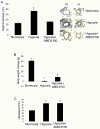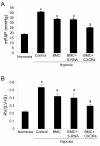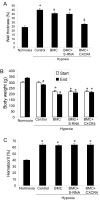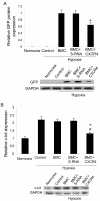Effect of chemokine receptor CXCR4 on hypoxia-induced pulmonary hypertension and vascular remodeling in rats
- PMID: 21294880
- PMCID: PMC3042398
- DOI: 10.1186/1465-9921-12-21
Effect of chemokine receptor CXCR4 on hypoxia-induced pulmonary hypertension and vascular remodeling in rats
Abstract
Background: CXCR4 is the receptor for chemokine CXCL12 and reportedly plays an important role in systemic vascular repair and remodeling, but the role of CXCR4 in development of pulmonary hypertension and vascular remodeling has not been fully understood.
Methods: In this study we investigated the role of CXCR4 in the development of pulmonary hypertension and vascular remodeling by using a CXCR4 inhibitor AMD3100 and by electroporation of CXCR4 shRNA into bone marrow cells and then transplantation of the bone marrow cells into rats.
Results: We found that the CXCR4 inhibitor significantly decreased chronic hypoxia-induced pulmonary hypertension and vascular remodeling in rats and, most importantly, we found that the rats that were transplanted with the bone marrow cells electroporated with CXCR4 shRNA had significantly lower mean pulmonary pressure (mPAP), ratio of right ventricular weight to left ventricular plus septal weight (RV/(LV+S)) and wall thickness of pulmonary artery induced by chronic hypoxia as compared with control rats.
Conclusions: The hypothesis that CXCR4 is critical in hypoxic pulmonary hypertension in rats has been demonstrated. The present study not only has shown an inhibitory effect caused by systemic inhibition of CXCR4 activity on pulmonary hypertension, but more importantly also has revealed that specific inhibition of the CXCR4 in bone marrow cells can reduce pulmonary hypertension and vascular remodeling via decreasing bone marrow derived cell recruitment to the lung in hypoxia. This study suggests a novel therapeutic approach for pulmonary hypertension by inhibiting bone marrow derived cell recruitment.
Figures






Similar articles
-
Neutralization of CXCL12 attenuates established pulmonary hypertension in rats.Cardiovasc Res. 2020 Mar 1;116(3):686-697. doi: 10.1093/cvr/cvz153. Cardiovasc Res. 2020. PMID: 31173066
-
Inhibition of the SDF-1/CXCR4 axis attenuates neonatal hypoxia-induced pulmonary hypertension.Circ Res. 2009 Jun 5;104(11):1293-301. doi: 10.1161/CIRCRESAHA.109.197533. Epub 2009 May 7. Circ Res. 2009. PMID: 19423843 Free PMC article.
-
Bioactive fraction of Rhodiola algida against chronic hypoxia-induced pulmonary arterial hypertension and its anti-proliferation mechanism in rats.J Ethnopharmacol. 2018 Apr 24;216:175-183. doi: 10.1016/j.jep.2018.01.010. Epub 2018 Jan 8. J Ethnopharmacol. 2018. PMID: 29325918
-
A brief overview of mouse models of pulmonary arterial hypertension: problems and prospects.Am J Physiol Lung Cell Mol Physiol. 2012 May 15;302(10):L977-91. doi: 10.1152/ajplung.00362.2011. Epub 2012 Feb 3. Am J Physiol Lung Cell Mol Physiol. 2012. PMID: 22307907 Free PMC article. Review.
-
Significance of nitric oxide derived from the nitric oxide synthases system in cardiovascular interorgan crosstalk.J Pharmacol Exp Ther. 2025 Feb;392(2):100025. doi: 10.1124/jpet.124.002222. Epub 2024 Nov 22. J Pharmacol Exp Ther. 2025. PMID: 40023592 Review.
Cited by
-
Effect of thoracic epidural blockade on hypoxia-induced pulmonary arterial hypertension in rats.Iran J Basic Med Sci. 2014 Sep;17(9):710-5. Iran J Basic Med Sci. 2014. PMID: 25691949 Free PMC article.
-
CXCR4 inhibition ameliorates severe obliterative pulmonary hypertension and accumulation of C-kit⁺ cells in rats.PLoS One. 2014 Feb 24;9(2):e89810. doi: 10.1371/journal.pone.0089810. eCollection 2014. PLoS One. 2014. PMID: 24587052 Free PMC article.
-
Time Series Gene Expression Profiling and Temporal Regulatory Pathway Analysis of Angiotensin II Induced Atrial Fibrillation in Mice.Front Physiol. 2019 May 29;10:597. doi: 10.3389/fphys.2019.00597. eCollection 2019. Front Physiol. 2019. PMID: 31191333 Free PMC article.
-
Cytokines, Chemokines, and Inflammation in Pulmonary Arterial Hypertension.Adv Exp Med Biol. 2021;1303:275-303. doi: 10.1007/978-3-030-63046-1_15. Adv Exp Med Biol. 2021. PMID: 33788198
-
The intricate role of CXCR4 in cancer.Adv Cancer Res. 2014;124:31-82. doi: 10.1016/B978-0-12-411638-2.00002-1. Adv Cancer Res. 2014. PMID: 25287686 Free PMC article. Review.
References
-
- Rabinovitch M. Hypoxic Pulmonary Vasoconstriction Cellular and Molecular Mechanisms. Chap 23. J. Yuan, Kluwer Academic Publishers. Boston, MA; 2004. Pulmonary vascular remodeling in hypoxic pulmonary hypertension; pp. 403–418. full_text.
Publication types
MeSH terms
Substances
Grants and funding
LinkOut - more resources
Full Text Sources
Medical
Molecular Biology Databases

